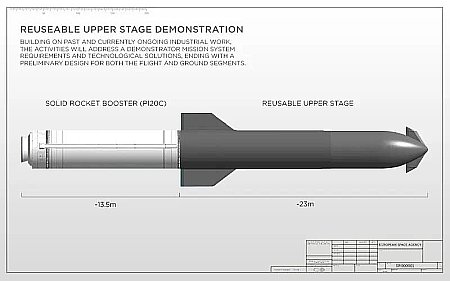ESA awards contract to Italian company to provide an ocean landing platform
The European Space Agency (ESA) has awarded the Italian company Ingegneria Dei Sistemi (IDS) a contract to build an ocean vessel for recovering the planned reusable test upper stage being built by the Italian rocket company Avio, as shown in the graphic to the right.
In late September, ESA awarded a €40 million contract to Avio for the design of a reusable rocket upper stage. The project scope encompasses preliminary design work, including system requirements and technological solutions, for both the launch system and the ground segment. According to the agency, the project has a number of potential applications, including as an evolution of Avio’s Vega family of rockets.
On 15 October, IDS announced that it had been awarded the contract to design the project’s recovery vessel, which falls under the systems ground segment. The company has subcontracted Italian naval systems consultancy Cetena and Norwegian shipbuilder Vard to assist with the project.
ESA very clearly is trying to encourage the development of reusable rockets by Europe’s private sector, but the nature of this particular program seems badly thought out. Rather than have Avio design the system in its entirety, in order to make it as efficient and profitable as possible, it appears ESA is micromanaging the design process, and thus bringing other subcontractors in who are outside Avio’s control. As a result, the final demo might work, but it is not likely it will be competitive with the private reusable rockets being built in the U.S. and elsewhere. Too many cooks in the kitchen.
The European Space Agency (ESA) has awarded the Italian company Ingegneria Dei Sistemi (IDS) a contract to build an ocean vessel for recovering the planned reusable test upper stage being built by the Italian rocket company Avio, as shown in the graphic to the right.
In late September, ESA awarded a €40 million contract to Avio for the design of a reusable rocket upper stage. The project scope encompasses preliminary design work, including system requirements and technological solutions, for both the launch system and the ground segment. According to the agency, the project has a number of potential applications, including as an evolution of Avio’s Vega family of rockets.
On 15 October, IDS announced that it had been awarded the contract to design the project’s recovery vessel, which falls under the systems ground segment. The company has subcontracted Italian naval systems consultancy Cetena and Norwegian shipbuilder Vard to assist with the project.
ESA very clearly is trying to encourage the development of reusable rockets by Europe’s private sector, but the nature of this particular program seems badly thought out. Rather than have Avio design the system in its entirety, in order to make it as efficient and profitable as possible, it appears ESA is micromanaging the design process, and thus bringing other subcontractors in who are outside Avio’s control. As a result, the final demo might work, but it is not likely it will be competitive with the private reusable rockets being built in the U.S. and elsewhere. Too many cooks in the kitchen.


